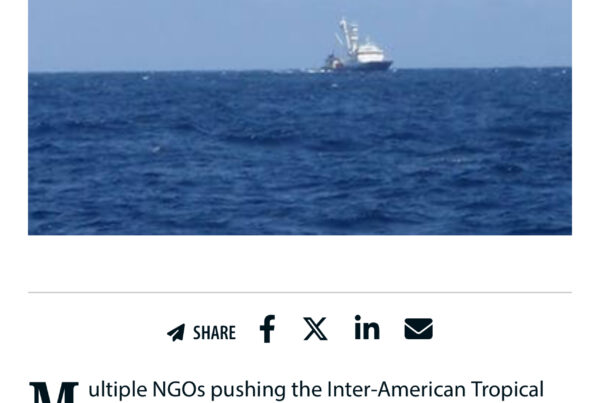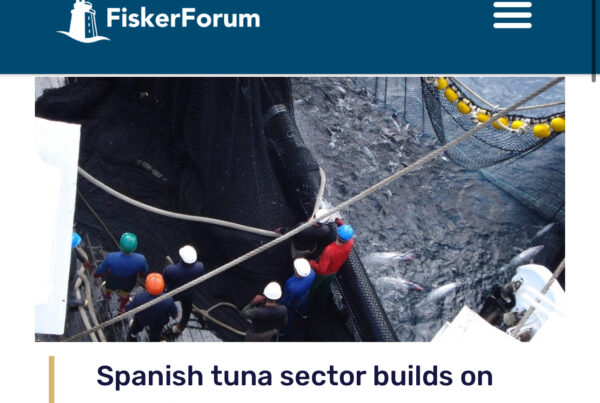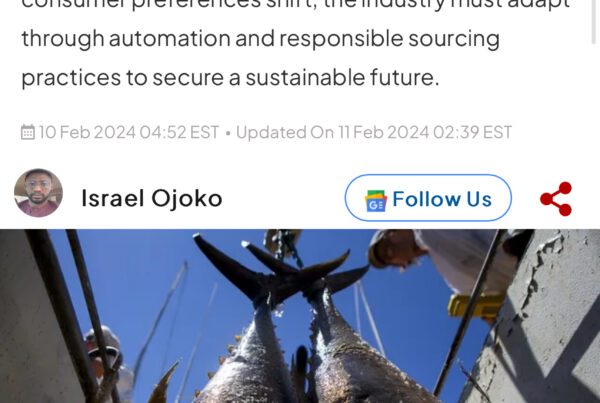Latest Fishing News
26 October-1 November 2021
Princes Slashes Indian Ocean Yellowfin Tuna Sourcing in Half
Canned food giant Princes has reduced the amount of Indian Ocean yellowfin tuna it sources by 51% on 2017 levels, a year ahead of its 50% deadline by 2022.
The drop represents the equivalent of 70 million cans a year, in the face of mounting concerns of an impending crash in stocks due to overfishing. Princes is now forecasting its 2021 sourcing from the fishery will be approximately 16,141 tonnes of yellowfin, compared with its 2017 base figure of 32,768 tonnes.
However, the business admitted it faced “an uphill battle to maintain the 50% reduction into 2022, as the pandemic created an unusual set of circumstances that helped it to achieve its goal a year ahead of its target”. Continue reading here (Source: The Grocer).
IATTC Approves Pacific Bluefin Tuna Quota Increase
The Inter-American Tropical Tuna Commission (IATTC) has approved a higher catch limit for Pacific bluefin tuna.
Based on IATTC Scientific Committee projections that indicated a 100 percent chance of reaching an initial stock rebuilding target by 2024, the IATTC approved a 15 percent increase in the catch limit for adults (over 30 kilograms) and no change for juveniles. The decision was made at IATTC’s full commission meeting, which ran from 13 to 22 October.
For countries that do not have a large fish catch-limit, an additional 30 metric tons (MT) will be allowed in the Western and Central Pacific Ocean, and 200 MT in the case of the Eastern Pacific Ocean. A conversion factor of 0.68 can be applied to 10 percent of the limit for small fish. The idea behind the conversion is that the same weight in large fish is made up of a smaller number of fish, so fishing small fish has a greater effect on the stock. Countries without a large fish catch-limit can apply the conversion to 25 percent of the limit. Up to 17 percent of the catch-limit could be carried over to the next year if unused in the Western and Central Pacific, while the Eastern Pacific uses a biannual carryover. Continue reading here (Source: SeafoodSource).
Bumble Bee Seafoods Celebrates National Seafood Month with Debut of New Product Innovations
In the month meant for celebrating all things seafood, Bumble Bee Seafoods, the 120-year-old iconic household brand and category leader, is evolving the Bumble Bee Prime™ product line, formerly known as Prime Fillet®. The updated Prime product line includes both canned tuna and salmon products, as well as a new on-the-go snack kit format. Bumble Bee Prime products are known for delivering the best-tasting, highest quality, and most elevated gourmet tuna experience on the market.
“The Bumble Bee Prime product line is designed to offer a premium experience that is accessible enough for every day,” said Jeanine Lewis, Vice President of Brand Marketing, Bumble Bee Seafoods. “Before we began the process of evolving this product line, we started by talking to thousands of consumers to ensure we could meet their changing needs. We’re confident our upgraded Prime line will deliver the flavor, nutrition and variety consumers told us they are looking for.” Continue reading here (Source: Business Wire).
Peru Defends “Paper Park” That Allows Industrial Fishing
In 2019, the Peruvian government announced it would establish two new marine protected areas in its waters by 2021: the Nasca Ridge National Reserve off Peru’s southwest coast; and the Grau Tropical Marine Reserve to the north of the country.
The aim was to conserve the great biodiversity of these areas and enhance their social, economic and natural value. It also meant that Peru would be moving the dial on the international commitment, made in 2010 under the UN Convention on Biological Diversity, to have at least 10 percent of the ocean covered by protected areas by 2020.
The idea for the Grau Tropical Marine Reserve dates back to 2016. This 340 square nm zone, where the Equatorial and Humboldt currents converge, is home to more than 70 percent of the species found in Peru’s waters. However, its creation has stalled due to opposition from some fossil fuel companies, who fear losing their exploitation rights in 10 nearby oil lots. Continue reading here (Source: The Maritime Executive).
French Polynesia Seizes Chinese Fishing Vessel
French Polynesian courts have approved the seizure of a Chinese fishing vessel after its owner refused to salvage a previous shipwreck.
The impounding of Ping Tai Rong 316, owned by Ping Tai Rong Ocean Fishery Group, was approved on Oct. 19 as collateral for the cost of the stranded ship’s removal.
It was a first for French Polynesia and was aimed at ensuring the estimated $4.8 million cost of retrieving tuna longliner Ping Tai Rong 49 — which has been stranded on a reef at Anuanurunga atoll since July 23 — is borne by the Chinese fishery outfit.
US Retail Seafood Sales Spike in the First Three Quarters of 2021
Frozen and fresh seafood sales reached nearly USD 5.5 billion (EUR 4.8 billion) in sales for the first nine months of 2021, with fresh sales leading the way in dollar and volume growth, according to new data.
Fresh seafood sales spiked 3.9 percent by value and 2.9 percent by volume and frozen seafood sales grew 2 percent by value, but shrunk 2.4 percent by volume through the first three quarters of 2021, according to research firms IRI and 210 Analytics.
“When compared to the pre-pandemic 2019 levels, all three areas (fresh, frozen, and ambient) easily trended ahead,” 210 Analytics Principal Anne-Marie Roerink told SeafoodSource. Frozen seafood sales spiked more than 40 percent ahead of 2019, while fresh seafood sales jumped 33.7 percent compared to 2019. Continue reading here (Source: SeafoodSource).
Progress for Eastern Pacific Ocean Tuna Fisheries: Protections, Monitoring for Tuna Stocks and Improved FAD Management
After repeated calls for action to protect Eastern Pacific Ocean (EPO) tuna stocks, we are relieved that last week’s Inter-American Tropical Tuna Commission (IATTC) meeting yielded positive results in advancing the Commission’s agenda on tuna protections and fish aggregating device (FAD) management, among other top-priority topics this year.
ISSF issued a position statement before the meeting calling for the adoption of a precautionary and science-based new version of the previous IATTC tuna conservation measure, which was ineffective in limiting catches of yellowfin, bigeye and skipjack. Fortunately, IATTC parties came to the meeting ready to work. It was gratifying to see IATTC member states and the Commission President work together in the months preceding the meeting, resulting in agreement on many issues prior to its start.
The Commission took action to safeguard tropical tuna stocks by adopting a new, enhanced tropical tuna measure. The improved measure includes additional fishery closure days for vessels that exceed a certain bigeye tuna annual catch threshold, while continuing the 72-day full closure for purse seine vessels, the “corralito” time/area closure, and bigeye catch limits for longline vessel. Continue reading here (Source: International Seafood Sustainability Foundation).



